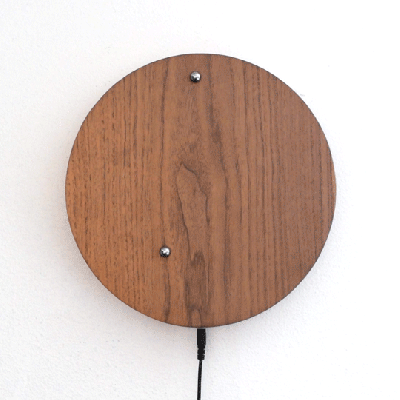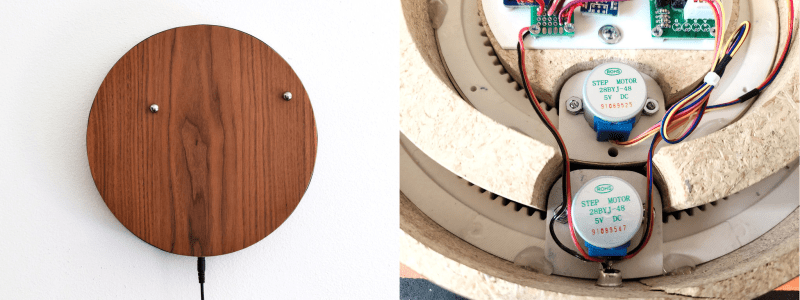Timepieces are cool no matter how simplistic or granular they are. Sometimes its nice not to know exactly what time it is down to the second, and most of the really beautiful clocks are simple as can be. If you didn’t know this was a clock, it would still be fascinating to watch the bearings race around the face.
 This clock takes design cues from the Story clock, a visual revolution in counting down time which uses magnetic levitation to move a single bearing around the face exactly once over a duration of any length as set by the user. As a clock, it’s not very useful, so there’s a digital readout that still doesn’t justify the $800 price tag.
This clock takes design cues from the Story clock, a visual revolution in counting down time which uses magnetic levitation to move a single bearing around the face exactly once over a duration of any length as set by the user. As a clock, it’s not very useful, so there’s a digital readout that still doesn’t justify the $800 price tag.
[tomatoskins] designed a DIY version that’s far more elegant. It has two ball bearings that move around the surface against hidden magnets — an hour ball and a minute ball. Inside there’s a pair of 3D-printed ring gears that are each driven by a stepper motor and controlled with an Arduino Nano and a real-time clock module. The body is made of plywood reclaimed from a bed frame, and [tomatoskins] added a walnut veneer for timeless class.
In addition to the code, STLs, and CAD files that birthed the STLs, [tomatoskins] has a juicy 3D-printing tip to offer. The gears had to be printed in interlocked pieces, but these seams can be sealed with a solution of acetone and plastic from supports and failed prints.
If you dig minimalism but think this clock is a bit too vague to read, here’s a huge digital clock made from small analog clocks.















Does the ball bearing roll or slide?
If it slides it will produce wear rings (faster) which might actually look cool.
This were something I too noticed.
But if one coats the wood in a sufficiently thick layer of clear varnish, then it would take a lot longer before it starts wearing into the wood itself.
Though, one would still expect tracks to form in the varnish, but that is likely less noticeable.
tracks in the finish may be repairable more easily than, and less visually intrusive, than into the wood.
And one can always sand it down a bit, polish and re-varnish it as routine maintenance if the tracks becomes a too big problem.
Would though be fun to put the thing into a depositioning chamber and build a transparent ceramic coating on it. Since that would likely be harder then the ball bearing itself and therefor not wear.
But putting wood into such a chamber is likely not the most fun experience in the world… And wood is likely not an ideal building substrate either…
Could also cover the wood with a sheet of glass for very high wear resistance. Get a cheap Ikea clock to source the round glass 😉
I like it.
Or just get rid of the wood entirely and use a round piece of frosted glass.
I knew there would be a use for those 34 microwave turntables I saved some day.
Being a sphere, there is no reason it shouldn’t roll.
Lets put a sharpie mark on it so that we can actually study this.
A smooth silvery ball bearing is a bit hard to tell if it rolls or slides after all.
There is… it’s sort of like a coil in that when you “charge” it with a field it forms a dipole magnet, that then resists changes in the field, so when the magnet moves a fraction forward, it’s not attracting fresh steel, but the bottom of the dipole it just moved away from. If it was a hollow steel ball it with a shell thickness much smaller than radius (under a 5th I’d guess) then it would more than likely roll. However, there’s probably some balance between sliding friction and speed that will make a solid ball roll.
Additionally, unless the balls are soft iron, like a transformer core, that won’t take permanent magnetisation, they either start with or very quickly acquire a magnetisation from sitting on the magnet while you’ve got it switched off, or when leaving it overnight.
The balls are moving far too slowly for any motion effects to be influential, but they are also moving often enough to prevent the ball from becoming permanently magnetized if it is rolling. The sharpie is the ultimate judge here but my vote goes to rolling.
Fat-fingered the report comment link, please disregard kthx
Localroger
Thanks for instilling confidence in my truly scientifically tested method of determining if a ball bearing is rolling or sliding.
Now we only need to perform the actual test….
If you wanted it to slide, you could use a disc magnet instead of a sphere.
I did something similar with a cheapo clock, I spray painted the whole thing black, including the acrylic cover, got rid of the minute and second hands, and hot glued a neodymium magnet to the hour hand.
A single, small ball bearing went around the face, once every twelve hours.
You gave me an idea. If I get a large clock, hot glue a strong magnet on the front of the hour hand, and another in the back of the minute hand, maybe it can have both the hour and minute indicators.
How about putting your clock underneath a dish of ferromagnetic fluid and have the distortions in the FF display the time.
I like and don’t mean to disparage,.. distancing is getting to me… but it bothers me that one could take a cheap quartz movement, hot glue on some Nd mags, place behind veneer and achieve similar… would be neat to try to hand wind lots of wire-nail electromagnets and see if they could be sequenced to pass the bearing from position to position
Easy, you just get a cheap quartz movement and use the hands as a wiper arm to switch the electromagnets :-D
lol, well played.
But… but… but… where would you put the Arduino?
The cheap quartz movement won’t have the torque required.
Those are steel balls. Perhaps bearing-balls. Definitely not ball bearings.
A ball bearing has an inner and outer race, separated by multiple steel balls. I can hear my SKF-employed mech engineer father screaming in the distance.
Though the story clock is extremely expensive, a key is that the bearing ball actually levitates away from the surface. Given that that is quite complicated to achieve for something hanging vertically, I fail to see how the price completely unjustified.